Hagop Kevorkian Fund Fellowship for the conservation of Islamic ceramics
The Freer Gallery of Art and Arthur M. Sackler Gallery hold in trust some of the world’s finest ceramics from the Islamic world. A recent survey by the F|S Department of Conservation and Scientific Research (DCSR) showed that several of these works needed conservation treatment before being exhibited or published. To undertake this project, the Freer|Sackler received a generous grant from the Hagop Kevorkian Fund in support of a two-year fellowship that focuses on the treatment of ceramics. A second grant was awarded for the conservation of manuscripts and paintings from the Islamic world. Visit the Paper Conservation: Current Projects page for more information on the manuscript conservation fellowship.
The ceramic conservation fellowship began in the fall of 2012 with the treatment of several unstable objects that were identified in the condition survey. Six ceramics suffered from soluble salts and/or chemically unstable glazes. They were degrading actively, which could have led to losses or other damage. These objects were treated in order to minimize the process of alteration.
After the works were stabilized, a list of treatment priorities was put together with help from Massumeh Farhad, chief curator and curator of Islamic art. The top priority was to treat ceramics that required conservation before they could be displayed in the galleries. Most of these works had been restored previously—many before they were acquired by the Freer|Sackler—and their restorations had aged and discolored.
Among these ceramics, a ninth-century dish from Iraq (F1957.23) required a long and complicated treatment. This shallow dish, with a lustrous golden glaze on relief decoration, had much discolored paint from old repairs, which often covered the original surface. Many of the joins were also uneven and misaligned. The old repairs were removed and the sherds taken apart; the pieces were then reassembled and the losses filled and toned. For more details on this treatment, please see the article "Conservation Treatment: The Case of a Ninth-Century Dish from Iran."
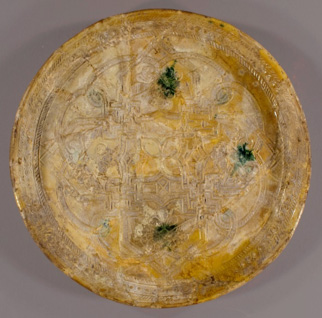
Dish F1957.23 before treatment
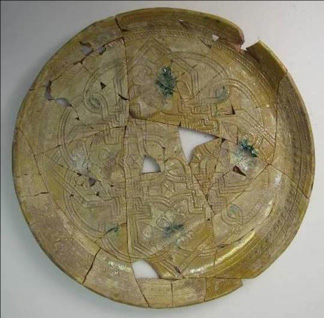
Dish F1957.23 during treatment: after reassembly of the sherds.

Dish F1957.23 after treatment
Another dish (F1953.70, see image below), dated from tenth-century in Iran or Afghanistan, needed treatment to improve its appearance. Integrating the losses and break lines was chosen as an approach to restoration for this object. The treatment consisted in removing the previous fills and paint and to fill the losses as well as all the cracks and chips. The fills were then in-painted. On the reverse side, the cracks were left unfilled in order to make the fragmentary condition of the object visible and understandable to potential handlers and scholars.

Dish F1953.70 before treatment

Dish F1953.70 after treatment
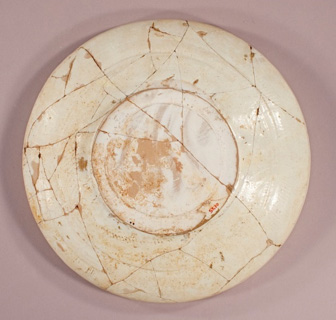
Back of dish F1953.70 before treatment
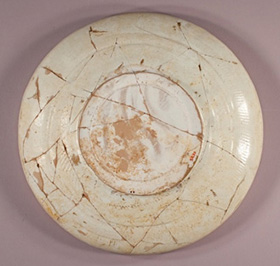
Back of dish F1953.70 after treatment
An important part of the fellowship has been devoted to the group of mina’i ceramics, produced between the end of the twelfth century and the beginning of the thirteenth century in Iran. The FreerǀSackler Galleries’ collections include 24 examples, including several world-renowned works. Having been highly prized by collectors at the end of the nineteenth and the beginning of the twentieth centuries, these ceramics have often been extensively repaired in the past to increase their value. Losses were sometimes filled by sherds from other ceramics, or by sherds manufactured to mimic the appearance of the original piece. Their condition needs to be precisely assessed before developing an overall approach to their conservation.
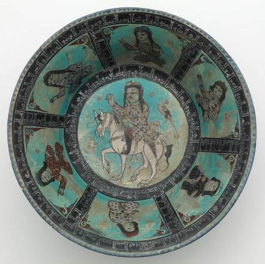
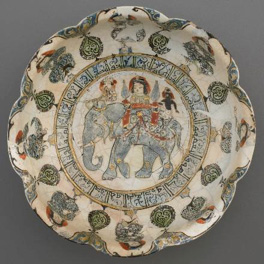

Examples of mina’i ceramics from the Freer|Sackler collection: from left to right, F1912.6, F1927.3, F1929.9
Stay tuned for more information about the Islamic ceramics project.
Conservation
OverviewObjects Conservation Paper Conservation
Exhibitions Conservation
East Asian Painting Conservation Studio
More about the Department
Scientific Research
Scientific research at the Freer and Sackler Galleries is primarily focused on the physical nature of artworks from Asian cultures. More info »
Staff Publications
Publication is an integral part of our research program. Click below to view lists of published works by past and present members of the department: